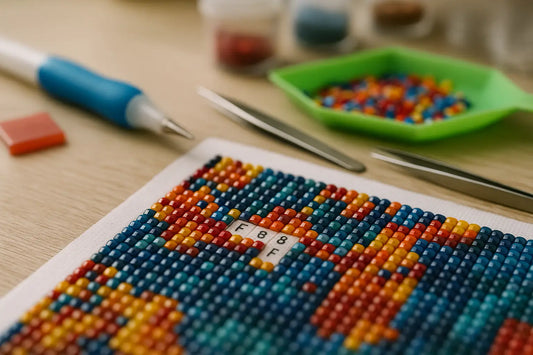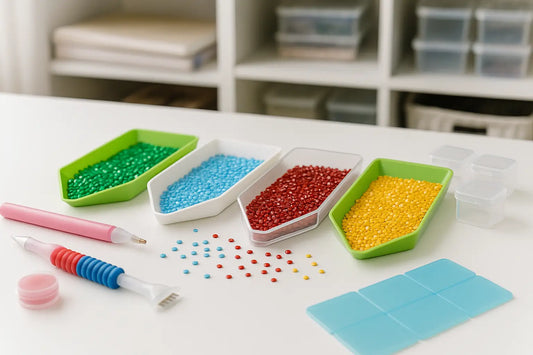Fun Diamond Painting Methods: 5 Creative Techniques to Try
Diamond painting is a relaxing and addictive hobby in which you place small, sparkling stones (also called drills) on a self-adhesive canvas to create a stunning work of art. It is not only a creative activity, but also an ideal way to relax after a busy day. The great thing is that there are countless diamond painting methods bestaan that you can use to finish your project faster, neater or in a more creative way. Whether you're a beginner creating your first canvas or an experienced diamond painter looking for new challenges: with the right technique your result becomes more beautiful and the process even more enjoyable. In this blog you'll discover five popular techniques, complete with practical tips to get started right away.

Why try different diamond painting methods?
By experimenting with Different techniques for diamond painting ontdek je niet alleen welke manier het beste bij jouw werkstijl past, maar ook hoe je jouw resultaten kunt verbeteren. Sommige methodes zijn ideaal om in korte tijd veel oppervlak te vullen, terwijl andere technieken juist zorgen voor strakkere lijnen en een gelijkmatig eindresultaat. Bovendien kan het afwisselen van werkwijzen het diamond painten leuk en uitdagend houden, waardoor je gemotiveerd blijft om je project af te ronden. Zo kan de ene methode handig zijn bij grote kleurvlakken, terwijl een andere techniek perfect werkt voor gedetailleerde patronen of overgangen tussen kleuren.
Would you like to learn more about the basics, materials, and first steps in addition to these diamond painting methods? Read our Beginner's Guide to Diamond Painting for a complete overview and extra tips to get started right away.
Make working with these diamond painting methods even easier with the right tools. Discover in our Diamond Painting Accessories Collection handy storage boxes, ergonomic pens and release paper, so you can always work comfortably and stay organized.
1. The Farmer's Method
At the farmers' method divide your larger color areas into smaller, manageable squares. You then “harvest” these squares one by one by filling them with stones of the same color. The word “harvesting” fits this method perfectly, because you fill the empty spots in your canvas step by step and thus slowly complete the whole area. This technique is especially useful for canvases with large, uniform sections, such as skies or background colors. It prevents you from getting lost in a sea of the same color and helps you work neatly and in a structured way.
An additional advantage is that you can more easily take breaks in between: you simply stop after finishing a box and pick up where you left off whenever you want. This makes the farmers' method ideal for people who like to work in short sessions.

2. The Ruler and Corrector Method
The ruler and correction method is perfect for anyone who loves clean, professional lines in their diamond painting. The principle is simple but highly effective. You start by placing a ruler along the first row of stones, creating a perfectly straight base. This helps you maintain a consistent pattern from the start, so the finished result looks crisp and polished.
Is something going wrong or do you notice a row is slightly off? That's when the stone corrector comes in handy. With this handy tool you gently nudge the stones into place so that all rows sit perfectly aligned. It's especially useful for square stones, because crooked placement is more noticeable. This method is ideal for beginner diamond painters who don't yet have a steady hand, but also for experienced crafters who want to perfect their work down to the smallest details.
For the ruler and corrector method, a stone corrector is essential to get your rows perfectly straight. View the Diamond Painting Corrector on Amazon from now on always work with crisp, professional lines in your diamond paintings.
3. The Block Method
The block method is a popular technique among diamond painters, especially for larger canvases. With this method you cut or slice the protective layer of your canvas into manageable blocks, for example 5x5 cm (but you can also choose larger or smaller sections, depending on your preference). You then finish each block separately.
The main advantage of this method is that you never expose too large an area of adhesive, so the glue layer stays clean and tacky. You don't have to worry about dust, hair or dirt sticking to the canvas. In addition, this technique helps you keep a clear overview step by step and take breaks in between without your work getting in the way.
Many diamond painters choose to work by color within each block, because this is more efficient and you have to switch stones less often. Others prefer to complete each block entirely to increase the sense of progress.
4. The Strip Method
The strip method lijkt sterk op de blokkenmethode, maar in plaats van kleine vierkante vakken werk je hier in lange, horizontale of verticale stroken. Je snijdt of vouwt de beschermlaag van je canvas in banen vrij, zodat je telkens een hele rij of kolom kunt afwerken. Dit geeft een prettig ritme tijdens het werken en zorgt ervoor dat je een duidelijk zicht krijgt op de voortgang van je project.
For this method it’s important to pay attention to your working position. Always start on the side where you don’t have to lean your arm over the canvas, so left for left-handed people and right for right-handed people. This prevents you from accidentally touching the adhesive layer or dislodging stones by moving over them.
The strip method is ideal for diamond paintings with many straight lines or patterns that run from top to bottom or from left to right. It provides a structured workflow and is especially useful if you want to work in longer sessions without taking many breaks.

5. The Checkerboard Method
The checkerboard method is one of the most popular and well-loved techniques among diamond painters. Here you place the stones in a checkerboard pattern, alternating, just like on a chessboard. You always leave an empty square between the placed stones. Once you've completed an entire section in this pattern, you fill the empty spots with the remaining stones.
This approach has several advantages. First of all, it provides a super sleek final result, because the stones effectively push each other into place when you fill the empty spaces. Secondly, it prevents the stones from shifting while you work, which makes a big difference especially with square stones. It’s also a handy method for keeping track with complicated patterns or lots of color changes, because you work step by step in a logical grid.
The checkerboard method may require some patience at first, but many diamond painters find that it ultimately allows them to work neater and more consistently. Especially on larger projects or detailed images, this technique can make the difference between a nice and an exceptionally crisp result.
Wondering how to apply the checkerboard method for a perfectly smooth finish? Discover on our blog Diamond Painting Checkerboard Method: How to Apply This Smart Technique step by step how this popular technique works and why it is so effective.
Tips to improve your diamond painting techniques
Besides these leuke manieren om diamond painting te maken", there are a number of handy tricks you can use to make each method even easier, faster and more enjoyable. With these extra tips you not only work more efficiently, but you also get a neater end result:"
-
Work with a light path for better color contrast
A light pad (light plate) illuminates your canvas from underneath, making symbols and color numbers easier to see. This is especially useful with dark colors or when symbols look similar. -
Keep your stones organized in jars or trays
A good storage system voorkomt dat beads from getting lost or mixed up. Use organizers with labeled jars or resealable bags, so you can quickly find the right color. -
Use round stones if you're a beginner, square ones for a neater finish
Round stones are easier to place and more forgiving of small imperfections. Square stones, on the other hand, fit together perfectly, giving a cleaner, glossier final result. -
Secure your canvas with painter's tape to prevent it from shifting.
By securing the edges of your canvas to your work surface with painter's tape, you prevent the canvas from moving while you work. This gives you greater precision, especially during long sessions.
These tips apply to all diamond painting methods die you've read in this blog, whether you work with blocks, strips or a checkerboard pattern. Small improvements to your workflow can make a big difference to the final result and to your enjoyment of the work.

Conclusion
Whether you choose the farmers' method, block method or checkerboard method: every technique has its own charm and advantages. One method helps you work faster, while another ensures a super-sleek final result. By using different diamond painting methods By trying different approaches, you'll discover which method best suits your working pace, preferences and the type of project you're working on. That way, diamond painting remains not only a creative hobby but also a fun journey of discovery full of new challenges.
We recommend not sticking to a single technique, but alternating depending on the design and your personal preference. That way you'll develop your skills, work more efficiently and get even more enjoyment out of each project.
Ready to try these techniques yourself?
View Here are all our Diamond Painting tools and accessories and discover everything you need to work faster, neater and more creatively. From ergonomic pens to storage boxes and release paper.




